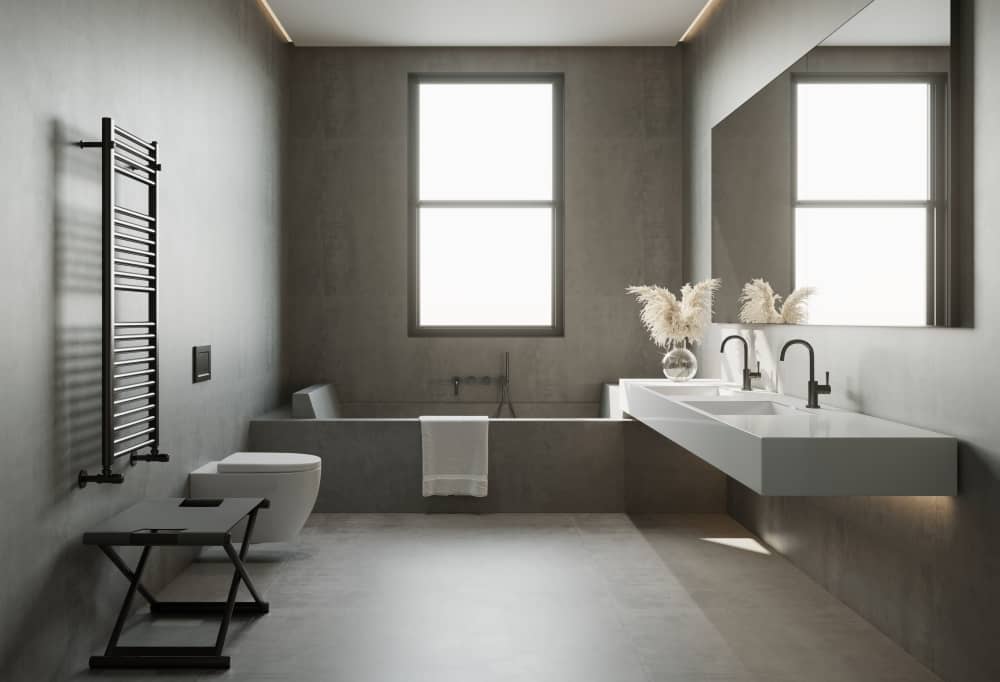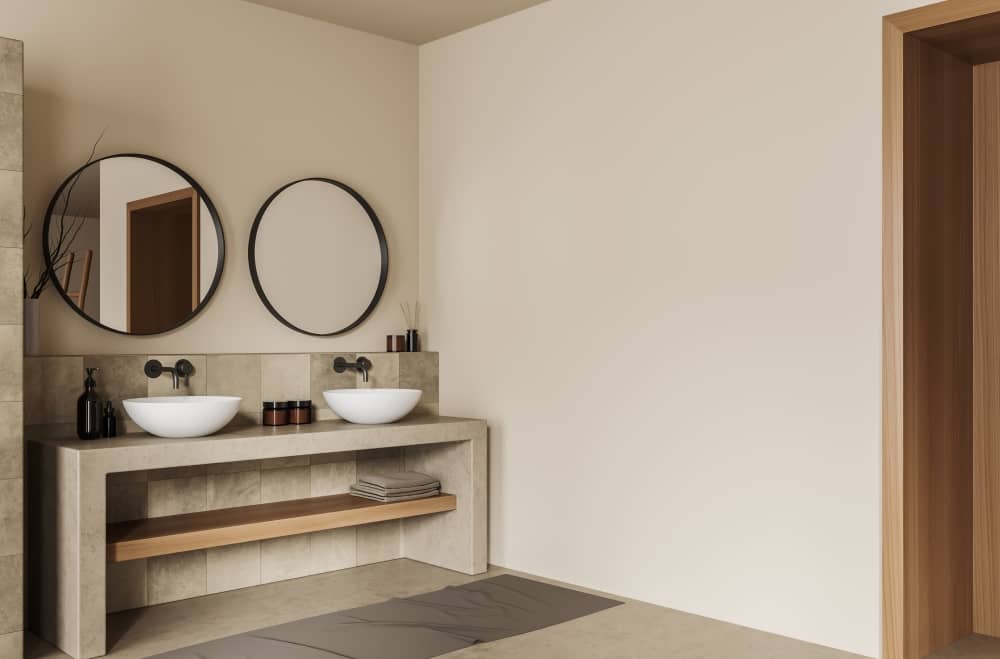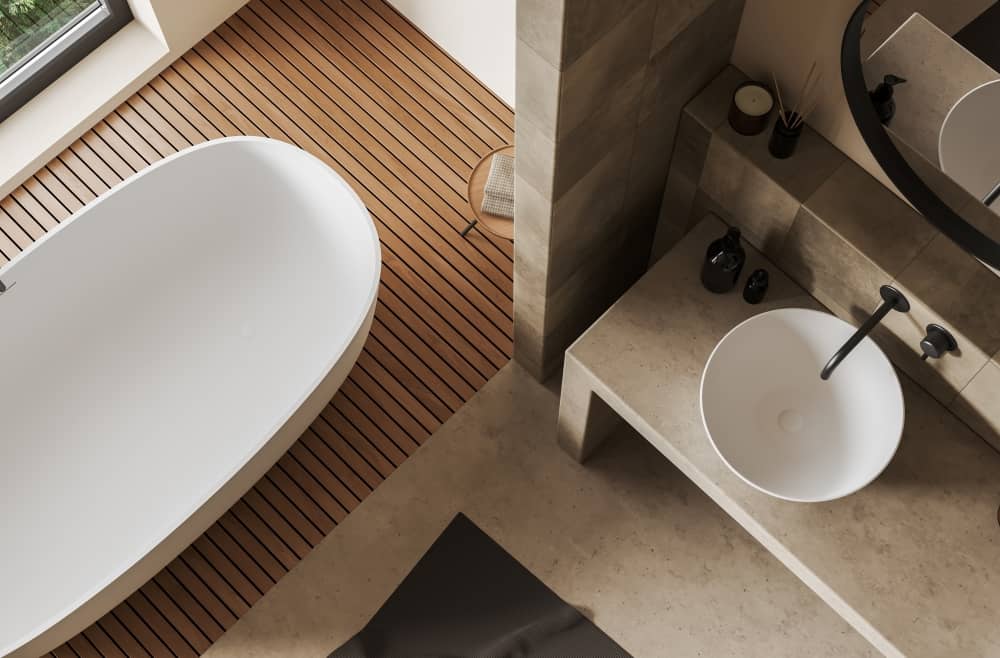Concrete Flooring for Bathrooms: Pros and Cons
- January 25, 2023
- Written By Brad Russell
- Guides
Concrete has always been viewed as one of the most reliable construction materials. It’s also versatile and can be used almost anywhere, including bathrooms. If you’re revamping your bathroom shower floor, is it a good choice? This blog explores the pros and cons of concrete in bathroom flooring, so you can decide whether it is the right material for you.
Pros of Using Concrete for Bathroom Floors
Concrete has been around since the 1800s. It has remained a constant in construction projects, including shower flooring. It’s usually in its grey form but can also appear in any number of hues and shapes. Concrete can be polished and honed to make it look smoother and shinier. If you’re considering using concrete for your bathroom floor, it can be an excellent idea due to the following reasons:
1. Water Resistance
When it comes to bathroom floors, one of the first things you need to check is whether the material is prone to water damage. Many are unaware that concrete is incredibly water resistant. When installed and maintained correctly, water will not easily seep through the material. That means the likelihood of water damage is extremely low.
Of course, concrete is not impervious to cracks and fissures. That’s why you must have flooring or concrete specialists check on your floors regularly. This way, they can point out possible issues and solve them before they worsen. Having concrete bathroom floors patched up will strengthen the area and stop moisture build-up.
2. Durability
According to Science Direct, concrete is impermeable, meaning water and other liquids cannot pervade the material. Apart from that, it can also resist frost, corrosion, and carbonisation. Whilst durability depends on exposure level, cement content, and grade or strength, most concrete mixtures are highly durable. Concrete can withstand the elements without a change in its structural integrity and quality, making it one of the top options for bathroom flooring.
One reason why it is a durable material is that it houses less organic content than its popular counterparts. Low levels of organic components equal a slower rate of degeneration, which is difficult to prevent with natural elements. Wood, for example, is a material that quickly deteriorates, making it prone to rot.
When exposed to high humidity and temperatures, concrete can resist weathering. However, it is important to note that moisture can still enter through the joints. That’s why regular inspection is a must.
3. Cleaning Convenience
Dry mopping and sweeping are generally the best ways to clean concrete bathroom floors. Concrete is easy to maintain for the most part, but it can still soak up dirt. When left dirty for a while, your floors can harbour mildew, so it makes sense to do some scrubbing periodically.
For stubborn stains, you can use bleach or ammonia – but don’t mix them. A natural concoction that you can make involves flour and hydrogen peroxide. Spread the paste on the stained area and let it sit overnight before scraping with a plastic scraper tool. If you don’t want to use the mentioned mixture, simply look for commercial solutions for cleaning concrete bathroom floors.
If you have a fancier type of concrete in the form of polished, your cleaning approach should be a little bit gentler. Mopping with a bucket of water mixed with a mild detergent is one of the easiest ways to keep the floors clean. Remember to avoid acidic substances on these floors, including ammonia and bleach, so you don’t damage them.
4. Economical
As tough as concrete may be, it is a flooring material that does not equate to a hefty price tag. It’s so cost-effective that it’s considered among the most economical construction materials around.
A contributing factor to why concrete is so inexpensive is the simplicity of its components. It contains aggregates, such as stones and glass, along with air and paste. This paste is generally a blend of cement and water. As you can see, its ingredients are all naturally sourced and do not require complicated extraction methods. Even manufacturing concrete is economical, making the finished product affordable. That’s why it is recommended even for expansive walk-in shower designs.
Cons of Using Concrete for Bathroom Floors
Just like with any other material, concrete does have its drawbacks. Bear the following in mind before you decide to use it for your bathroom flooring:
1. Sealants Required
Sure, you can have concrete bathroom floors without sealing them, but it also means they can stain easily. And no, we’re not talking about the artsy “staining.” It’s easily solvable, though, with the use of sealants.
Sealing concrete is needed to protect the surface whilst preserving its appearance. This is especially important if you have decorative concrete flooring, which can lose colour and vibrancy over time. Sealants are time-saving products that stop liquids from penetrating the material. That way, the water stays on top of the surface when you shower. However, neglecting to seal concrete will result in stains or, worse, damaged floors.
2. Hard and Cold
Many people don’t like how cold concrete can become, so they avoid using it for their shower area. Concrete has high thermal conductivity. Since the human body is warmer, heat flows from the body to the floor, making it feel colder.
However, it is a myth that concrete is the coldest of them all. It’s no colder than natural stone and ceramic tiles, two of the most commonly used materials in bathroom flooring. The good news is that concrete does not have to remain in low temperatures. If it is a huge issue, you can install radiant heating cables. They can keep the floors toasty warm, which is particularly helpful in the winter.
Another problem is standing for quite a while in the shower, which may cause fatigue and sometimes pain. It’s not ideal, especially for overweight people and those with flat feet. Standing on hard surfaces, such as concrete, can stress the plantar fascia (the ligament connecting the heels to the front of the foot). It can lead to heel pain that can last throughout the day. Not only that, it can contribute to leg and lower back aches.
You can take quick showers or stand on a thick mat to prevent or at least reduce the discomfort.
Is a Concrete Bathroom Floor Suitable for You?
Concrete has many vital features that make it an excellent choice for bathroom floors. However, it can also be problematic for certain people. Assess the pros and cons listed above and weigh them appropriately to decide whether this flooring material is good for you.
In most cases, concrete is the best option for bathroom flooring. If you choose to use it, don’t forget to contact Decorative Concrete WA for your concrete requirements.




